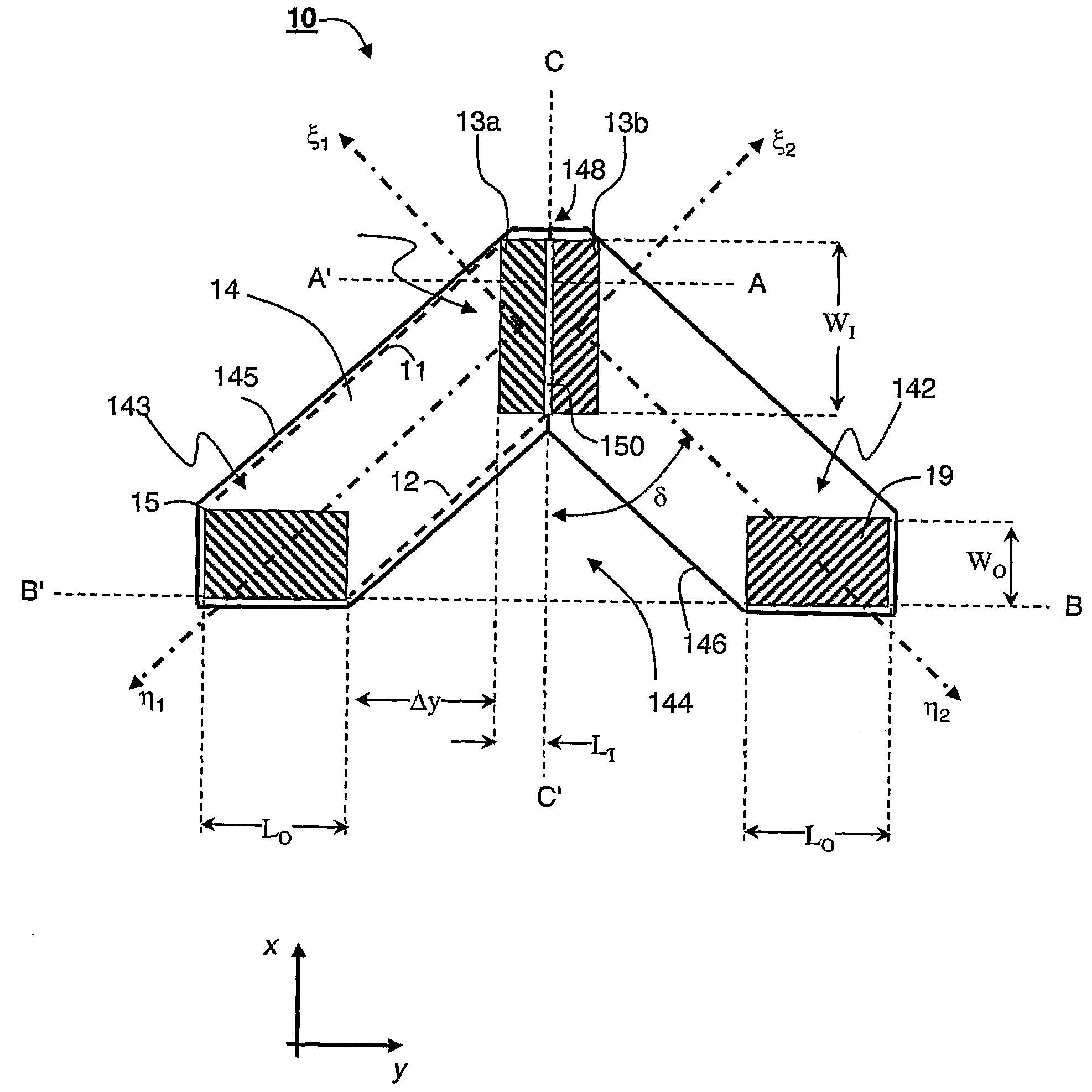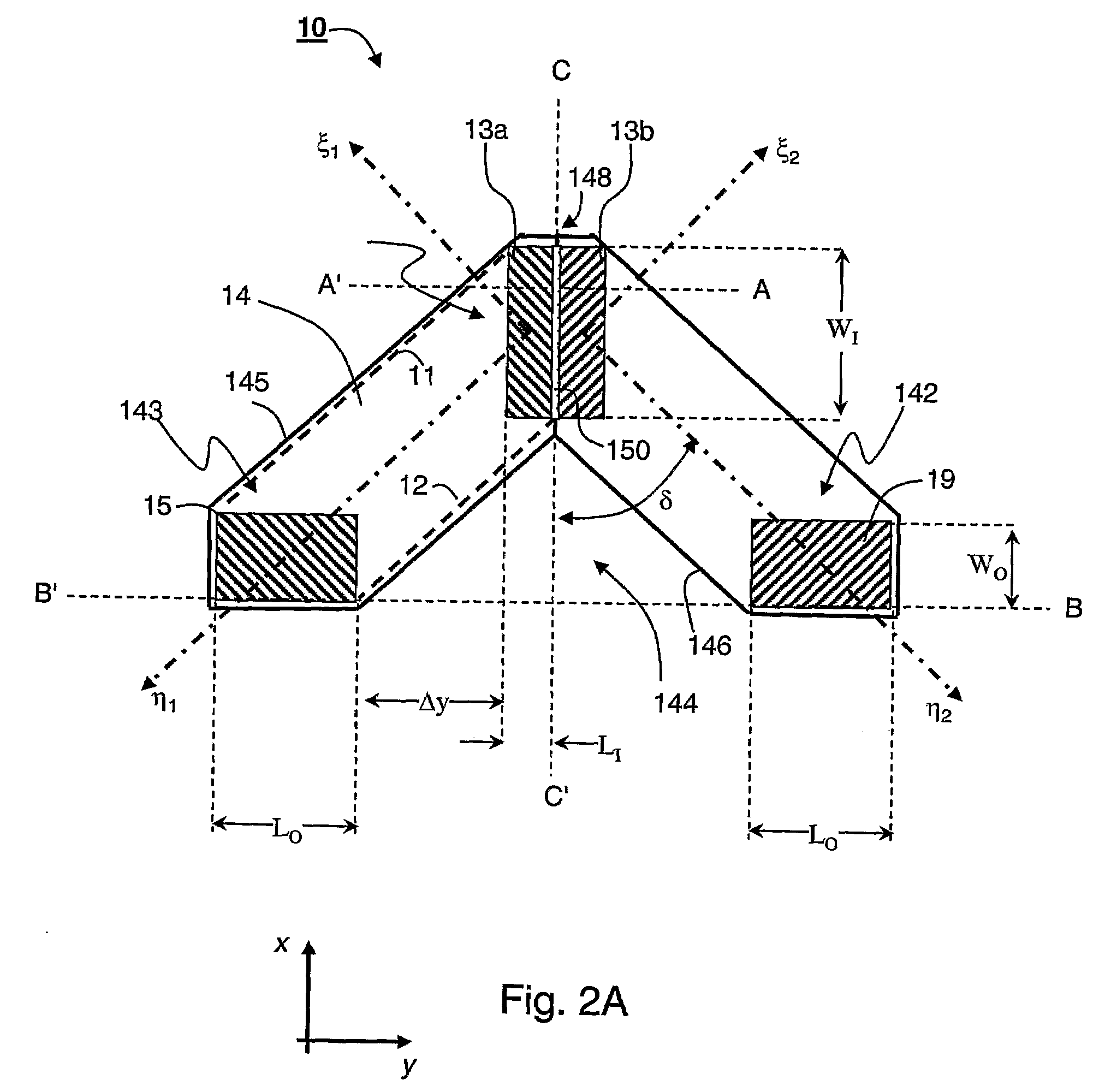Binocular Optical Relay Device
a technology of optical relay and binoculars, applied in the field of optics, can solve the problems of not being able to view sharp images at a closer distance, heavy crt display, bulky and not easily miniaturized, etc., and achieve the effect of reducing optical cross-talk
- Summary
- Abstract
- Description
- Claims
- Application Information
AI Technical Summary
Benefits of technology
Problems solved by technology
Method used
Image
Examples
example 1
[0264]Following is a non-limiting example in which planar dimension calculations are performed in accordance with the teachings of the preferred embodiments of the invention for the diffraction of red light.
[0265]The present calculations are for 509 nm period gratings formed in a light transmissive substrate having index of refraction of 1.522, thickness of 2 mm, and apex angle of δ=62°. As a representative example for red light, a wavelength of 615 nm was assumed.
[0266]With the above values of the grating period, index of refraction and wavelength a horizontal field-of-view Ωy of [−12.0°, +12.0°] and a transverse field-of-view Ωx of [−9.0°, +9.0°] can be achieved. The overall (diagonal) field-of-view Ω is calculated using Equation 5 to obtain Ω=[−15°, +15°].
[0267]For Δz=25 mm, the minimal dimensions of the output optical element(s) are (see Equation 6) LO, min=10.6 mm and WO, min=7.9 mm. For LEB=4 mm, WEB=1 mm and Op=3 mm, the dimensions of the output optica...
example 2
[0271]Following is a non-limiting example in which planar dimension calculations are performed in accordance with the teachings of the preferred embodiments of the invention for the diffraction of blue light.
[0272]The present calculations are for 370 nm period gratings formed in a light transmissive substrate having index of refraction of 1.529, thickness of 1.8 mm, and apex angle of δ=60°. As a representative example for blue light, a wavelength of 465 nm was assumed.
[0273]With the above values of the grating period, index of refraction and wavelength a horizontal field-of-view Ωy of [−12°, +12°] and a transverse field-of-view Ωx of [−9°, +9°] can be achieved. The overall (diagonal) field-of-view Ω is calculated using Equation 5 to obtain Ω=[−15°, +15°].
[0274]For Δz=20 mm, the minimal dimensions of the output optical element(s) are LO, min=7.8 mm and WO,min=5.8 mm. For LEB=5 mm, WEB=2 mm and Op=3 mm the dimensions of the output optical element(s) are LO=15....
example 3
A Detailed Manufacturing Process
[0278]FIGS. 9A-L illustrate an exemplified embodiment for manufacturing the optical relay device according to the teachings of the present invention.
[0279]FIG. 9A schematically illustrates second substrate 218, which is preferably used for manufacturing the master substrate as further detailed hereinabove.
[0280]FIG. 9B schematically illustrates second substrate 218, once layer 220 of photoresist material is applied thereon.
[0281]FIG. 9C schematically illustrates second substrate 218, once pattern 222 is recorded on layer 220
[0282]FIG. 9D schematically illustrates second substrate 218, once the photoresist is developed to form mask pattern 224 on layer the surface of substrate 218.
[0283]FIG. 9E schematically illustrates substrate 218 following the etching process which forms the inverted shape 202 of the grating on substrate 218.
[0284]FIG. 9F schematically illustrates substrate 218 following once mask pattern 224 is removed.
[0285]FIG. 9G schematically ...
PUM
 Login to View More
Login to View More Abstract
Description
Claims
Application Information
 Login to View More
Login to View More - R&D
- Intellectual Property
- Life Sciences
- Materials
- Tech Scout
- Unparalleled Data Quality
- Higher Quality Content
- 60% Fewer Hallucinations
Browse by: Latest US Patents, China's latest patents, Technical Efficacy Thesaurus, Application Domain, Technology Topic, Popular Technical Reports.
© 2025 PatSnap. All rights reserved.Legal|Privacy policy|Modern Slavery Act Transparency Statement|Sitemap|About US| Contact US: help@patsnap.com



